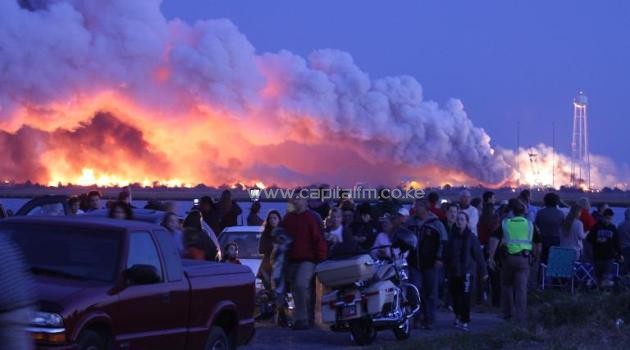
People who came to watch the launch walk away after an unmanned rocket owned by Orbital Sciences Corporation exploded (background) October 28, 2014 just seconds after lift-off from Wallops Island, Virginia/AFP
WASHINGTON, October 29 – An unmanned rocket owned by Orbital Sciences Corporation exploded in a giant fireball and plummeted back to Earth just seconds after launch on what was to be a resupply mission to the International Space Station.
“The Antares rocket suffered an accident shortly after lift off,” NASA mission control in Houston said, describing the blast at Wallops Island, Virginia, as a “catastrophic anomaly.”
Orbital’s unmanned Cygnus cargo ship was carrying 5,000 pounds (2,200 kilograms) of supplies for the six astronauts living at the research outpost.
After the countdown, the base of the tall, white rocket ignited on cue, then rose a short distance into the air before it suddenly exploded in a fiery blast six seconds later.
Enveloped in flames, the rocket collapsed to the ground, as a cloud of dark gray smoke rose from the wreckage.
Officials said the cost of the rocket and supplies was over $200 million, not including the damage caused on the ground.
Investigators swiftly secured the perimeter of the area and forbade any outside interviews of witnesses or staff, citing classified equipment that had been aboard the spacecraft.
As night fell, fires were seen burning at the coastal launch pad, where waves lapped at the shore.
It was unclear what caused the explosion, which occurred at 6:22 pm (2222 GMT).
“Something went wrong, and we will find out what that is,” said Frank Culbertson, executive vice president at Orbital Sciences.
He said investigators would evaluate the debris and analyze the rocket’s telemetry to uncover the exact sequence of events.
All personnel in the area were accounted for, and there were no injuries, officials said.
There was, however significant property damage at the launchpad.
It was the first nighttime launch of an Antares rocket, according to Orbital’s pre-launch blog.
Engineers said the countdown had gone smoothly, and there were no issues apparent with the machinery before the launch.
“We don’t really have any early indication of what might have failed,” Culbertson said.
– Space station well stocked –
The mission, known as CRS-3, was to be Orbital’s fourth trip to the ISS, including an initial demonstration flight.
Bill Gerstenmaier, associate administrator of NASA’s Human Exploration and Operations Mission Directorate, said the space station was well stocked and that no “absolutely critical” cargo was lost in the blast.
Orbital has a $1.9 billion contract with NASA for a total of eight supply missions.
After the US space shuttle program ended in 2011, leaving no government program to send humans to the space station, private companies raced to restore US access.
SpaceX’s Dragon was the first commercial spacecraft to make a supply journey there in 2010. Its next trip is scheduled for early December.
The Cygnus craft, which is shaped like a massive beer keg, made its first journey to the ISS in 2013.
Unlike the Dragon, which returns to Earth intact, the Cygnus burns up on re-entry to Earth’s atmosphere.
President Barack Obama was briefed on the launch failure and would continue to receive updates on the probe, the White House said.









































